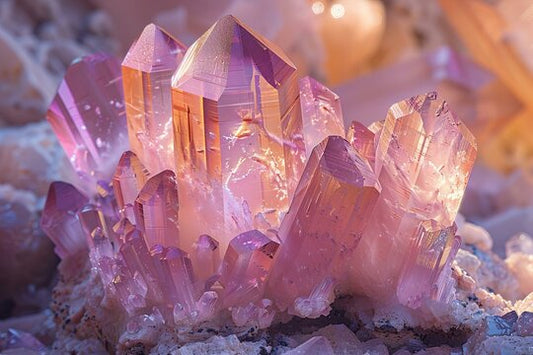
A is for Amethyst
Natalie IfillIn a brand new blog series: A-Z Gemstones Uncovered, we will be looking into the history of certain gemstones, and what's become of them over the years. For each post in this series we will be picking one gemstone from each letter of the alphabet. Today is A and A is for Amethyst!
Let's dive back to the very beginning...
It is unclear how long this beautiful gemstone has existed but there are records dating back to approximately 25,000 years ago in France. One legend of its discovery is that the Ancient Greek God, Dionysus, was the first person to discover this purple stone. Amethysts use in jewellery has also been traced back to the Neolithic period (roughly 4,000 BC) and pieces of it set into gold rings have been uncovered in burial sites from around 2,400 BC.

What is Amethyst and how is it formed?
The process of formation for Amethyst is long and complex, so we're going to take a very brief overview here! For a more in-depth explanation we recommend checking out The Origin and Science Behind How Amethyst Forms by Cosmic Cuts
Up until the 19th century, Amethyst was primarily found and mined in Russia. However once natural sources of Amethyst were discovered in Brazil, supply of this crystal dramatically increased. Today Amethyst can be found from all over the world, but is commonly sourced from the following:
- Africa (Zambia, Madagascar, Namibia, and South Africa)
- Australia
- Asia (Russia, South Korea, India and Sri Lanka)
- Europe (Hungary, Austria, Germany and Italy)
- North America (USA, Canada and Mexico)
- South America (Brazil and Uruguay)
What does the word 'Amethyst' mean?
Amethyst derives from the Greek word ‘Amethustos’, ‘a’ meaning ‘not’ and ‘methustos’ meaning ‘to intoxicate’. The Greek myth goes that Dionysius (the God of intoxication) got angered by a humans insult and swore revenge on the next mortal to cross his path. And that human ended up being Amethyst, a beautiful girl on her way to pay homage to the goddess Diana. To protect Amethyst from being attacked by Dionysius, Diana transformed Amethyst into a beautiful crystalline quartz to protect her. Dionysius who witnessed this felt bad about the actions he made to the innocent woman and began to cry tears of wine in remorse. Those tears of the god Dionysius stained that quartz in purple, and since then, the legend says that at this exact moment, the precious amethyst stone was created for the first time.
There are various myths and legends regarding the history of Amethyst. Here's another story, quoted below is a story from Greco-Roman mythology from “Birthstones” by Willard Heaps:
Although many debunked the myth that Amethyst would stop intoxication, this belief stuck. In ancient times, wealthy lords continued drinking from goblets made from Amethyst. Those who wanted to stop drinking, tricked their guests - while pouring wine for their guests, they could serve themselves water - the dark purple hue of the gemstone goblets would disguise the colour of their drink making it appear to be wine.

5 Facts about Amethyst:
- It was seen as a symbol of royalty. Cleopatra was known to favor this gemstone, and it was included amongst the crown jewels in Britain.
- It was previously classified as a precious gemstone. It was highly regarded, a favourite of royals and was hard to come by. It was comparable to diamonds. But since the discovery of its natural sources in South America, Amethyst has become a very common stone, therefore decreasing its rarity and devaluing the price. It is now considered a semi-precious gemstone.
- Amethyst can be turned into Citrine. When exposed to high levels of heat the colour of amethyst changes. When heated, natural amethyst loses its signature purple colour and turns a dark yellow or orange colour. Due to the rare nature of natural citrine, a large part of citrine available is heat-treated amethyst. Partially heated amethyst creates a yellow and purple crystal called ametrine.
- Amethyst is sacred in some religions and cultures. Tibetan Buddhist monks use Amethysts to make prayer beads. The beads are used during prayer and meditation to help the monks concentrate as the stone is seen as calming to the mind.
- Unlike most precious and semi-precious gemstones which value is measured by weight, Amethysts’ value is determined by the vibrancy of their colour. The rarest shade of amethyst is known as “Deep Russian” and it’s so uncommon that the price depends on the demand of collectors.
We'd love to hear your thoughts, what's your favourite thing about Amethyst or which gemstone would you like us to feature next! Comment below, like or share this post.








